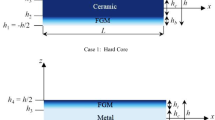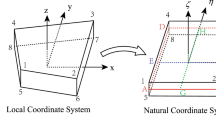Abstract
In this paper, a finite element-meshless hybrid method (FEMLHM) is proposed to numerically simulate the elasticity problems. In the proposed FEMLHM, the nodal displacement components of a discrete structure are determined by the finite element method (FEM). The approximation formulations of displacement field, strain field and stress field are all developed using the radial basis point interpolation method (RPIM), which is one of the meshless approximation methods. Especially, a compactly supported and higher-order continuous radial basis function is used in the RPIM to ensure that all fields of displacement, stress and strain are continuous in the whole problem domain. Therefore, the proposed FEMLHM overcomes the limitation that both fields of stress and strain are not continuous in the FEM. In addition, the nodal displacements are calculated by FEM, which makes the proposed FEMLHM has higher computational efficiency than a meshless method. The displacement field and stress field of a cantilever beam problem are first numerically simulated to verify the proposed FEMLHM. Then it is used to numerically simulate the stress fields of a circular ring under uniform pressures. The simulation results are compared with both FEM and analytical solution to illustrate that the proposed FEMLHM can numerically simulate an elasticity problem more effectively and accurately than FEM. The proposed FEMLHM is easy to use, and has an application potential in a lot of engineering and science fields.















Similar content being viewed by others
REFERENCE
G. Hamid, X. Z. Wang, S. Swarna, et al., “A review of elastic–plastic contact mechanics,” Appl. Mech. Rev. 69, 060804 (2017). https://doi.org/10.1115/1.4038187
X. Ma, B. Zhou, Y. J. Li, and S. F. Xue, “A Hermite interpolation element-free Galerkin method for elasticity problems,” J. Mech. Mater. Struct. 17, 75–95 (2022). https://doi.org/10.2140/JOMMS.2022.17.75
B. H. Wang, Y. Q. Ma, and Y. M. Cheng, “The improved complex variable element-free Galerkin method for bending problem of thin plate on elastic foundations” Int. J. Appl. Mech. 11, 1950105 (2019). https://doi.org/10.1142/S1758825119501059
E. Kubacka and P. Ostrowski, “Heat conduction issue in biperiodic composite using Finite Difference Method,” Compos. Struct. 261, 113310 (2021). https://doi.org/10.1016/J.COMPSTRUCT.2020.113310
D. G. Taylor and S. Li, “Stable inversion of continuous-time nonlinear systems by finite-difference methods,” IEEE. Trans. Automat. Contr. 47, 537–542 (2002). https://doi.org/10.1109/9.989157
X. Ma and G. Wei, “Numerical prediction of effective electro-elastic properties of three-dimensional braided piezoelectric ceramic composites,” Compos. Struct. 180, 420–428 (2017). https://doi.org/10.1016/j.compstruct.2017.07.081
B. Zhou, Z. T. Kang, Z. Y. Wang and S. F. Xue, “Finite element method on shape memory alloy structure and its applications,” Chin. J. Mech. Eng-En. 32, 1–11 (2019). https://doi.org/10.1186/s10033-019-0401-3
F. L. Sun, Y. P. Gong and C. Y. Dong, “A novel fast direct solver for 3D elastic inclusion problems with the isogeometric boundary element method,” J. Comput. Appl. Math. 77, 12904 (2020). https://doi.org/10.1016/j.cam.2020.112904
W. M. Elleithy and M. Tanaka, “Interface relaxation algorithms for BEM–BEM coupling and FEM–BEM coupling,” Comput. Methods. Appl. Mech. Eng. 192, 2977–2992 (2003). https://doi.org/10.1016/S0045-7825(03)00312-8
H. C. Nguyen and T. Vo-Minh, “The use of the node-based smoothed finite element method to estimate static and seismic bearing capacities of shallow strip footings,” J. Rock Mech. Geotech. Eng. 14, 180–196 (2022). https://doi.org/10.1016/J.JRMGE.2021.11.005
A. E. Demirbas, R. Ekici, M. Larakaya and A. Alkan, “Bone stress and damage distributions during dental implant insertion: a novel dynamic FEM analysis,” Comput. Methods. Biomech. Biomed. Eng. 25, 1381–1392 (2022). https://doi.org/10.1080/10255842.2021.2012765
G. Antonio, “FEM analysis of the stiffness evolution in clustered composites and nanocomposites,” Mech. Adv. Mater. Struct. 29, 2423–2436 (2022). https://doi.org/10.1080/15376494.2020.1864070
S. Adany, “Constrained shell finite element method for thin-walled members with holes,” Thin-Walled. Struct. 121, 41–56 (2017). https://doi.org/10.1016/j.tws.2017.09.021
J. Yang, W. **e and Z. W. Zhang, “Exploring three-dimensional edge-based smoothed finite element method based on polyhedral mesh to study elastic mechanics problems,” **bei. Gongye Daxue. Xuebao. 39, 747–752 (2021). https://doi.org/10.1051/jnwpu/20213940747
M. Alhazmi and S. E Ahmed, “FEM simulation of the entropy due to a buoyancy-induced flow confined novel prismatic enclosures using nano-encapsulated phase change materials,” Numer Heat. Transfer. Part. A. Appl. 83. 175–196 (2023). https://doi.org/10.1080/10407782.2022.2143974
K. K. Zhang, W. B Deng and H. J. Wu, “A combined multiscale finite element method based on the LOD technique for the multiscale elliptic problems with singularities,” J. Comput. Phys. 469, 111540 (2022). https://doi.org/10.1016/J.JCP.2022.111540
W. Y. Ming, C. Cao, F. Shen, et al., “Numerical and experimental study on WEDM of BN-AlN-TiB2 composite ceramics based on a fusion FEM model,” J. Manuf. Proc. 76, 138–154 (2022). https://doi.org/10.1016/j.jmapro.2022.02.013
D. J. Burns and R. C. Batra, “First failure load of sandwich beams under transient loading using a space–time coupled finite element method,” Thin-Walled Struct. 173, 108960 (2022). https://doi.org/10.1016/J.TWS.2022.108960
X. Ma, B. Zhou and S. F. Xue, “A meshless Hermite weighted least-square method for piezoelectric structures,” Appl. Math. Comput. 400, 1–15 (2021). https://doi.org/10.1016/J.AMC.2021.126073
X. Ma, B. Zhou and S. F. Xue, “A Hermite interpolation element-free Galerkin method for functionally graded structures,” Appl. Math. Comput. 419, 1–20 (2022). https://doi.org/10.1016/J.AMC.2021.126865
Y. J. Deng, X. Q. He, L. G. Sun, et al., “An improved interpolating complex variable element free Galerkin method for the pattern transformation of hydrogel,” Eng. Anal. Bound. Elem. 113, 99–109 (2020). https://doi.org/10.1016/j.enganabound.2019.12.004
Z. Liu, G. F. Wei and Z. M. Wang, “Geometrically nonlinear analysis of functionally graded materials based on reproducing kernel particle method,” Int. J. Mech. Mater. Des. 16, 487–502 (2020). https://doi.org/10.1007/s10999-019-09484-8
G. R. Liu, G. Y. Zhang, Y. T. Gu and Y. Y. Wang, “A meshfree radial point interpolation method (RPIM) for three-dimensional solids,” Comput. Mech. 36, 421–430 (2005). https://doi.org/10.1007/s00466-005-0657-6
X. B. Luo, D. M. Li, C. L. Liu and J. H. Pan, “Buckling analysis of variable stiffness composite plates with elliptical cutouts using an efficient RPIM based on naturally stabilized nodal integration scheme,” Compos. Struct. 302, 116243 (2022). https://doi.org/10.1016/J.COMPSTRUCT.2022.116243
S. W. Hu, R. Zhong, Q. S. Wang, et al., “A strong-form Chebyshev-RPIM meshless solution for free vibration of conical shell panels with variable thickness and fiber curvature,” Compos. Struct. 296, 115884 (2022). https://doi.org/10.1016/J.COMPSTRUCT.2022.115884
E. I. Seblani and E.Shivanian, “New insight into meshless radial point Hermite interpolation through direct and inverse 2-D reaction-diffusion equation,” Eng. Comput. 37, 3605–3613 (2021). https://doi.org/10.1007/s00366-020-01020-z
Q. **a, P. **ang, L. Z. Jiang, et al., “Bending and free vibration and analysis of laminated plates on Winkler foundations based on meshless layerwise theory,” Mech. Adv. Mater. Struct. 29, 6468–6187 (2022). https://doi.org/10.1080/15376494.2021.1972497
S. H. Ren, V. Mahesh, G. G. Meng and L. M. Zhou, “Static responses of magneto-electro-elastic structures in moisture field using stabilized node-based smoothed radial point interpolation method,” Compos. Struct. 252, 112696 (2020). https://doi.org/10.1016/j.compstruct.2020.112696
Y. Li, G. R. Liu, Z. Q. Feng, et al., “A node-based smoothed radial point interpolation method with linear strain fields for vibration analysis of solids,” Eng. Anal. Boundary. Elem. 114, 8–22 (2020). https://doi.org/10.1016/j.enganabound.2020.01.018
L. M. Zhou, S. H. Ren, G. W. Meng, and Z. C. Ma, “Node-based smoothed radial point interpolation method for electromagnetic-thermal coupled analysis,” Appl. Math. Model. 78, 841–862 (2020). https://doi.org/10.1016/j.apm.2019.09.047
A. Leblanc, A. Malesys, and A. Lavie, “Compactly supported radial basis functions for the acoustic 3D eigenanalysis using the particular integral method,” Eng. Anal. Boundary. Elem. 36, 520–526 (2012). https://doi.org/10.1016/j.enganabound.2011.10.007
P. Deng, X. L. Chen, B. Y. Yang, et al., “Finite element analysis on the residual bearing capacity of axially preloaded tubular T-joints subjected to impacts,” Struct. 31, 286–304 (2021). https://doi.org/10.1016/J.ISTRUC.2021.02.002
G. R. Liu and Y. T. Gu, An Introduction to Meshfree Methods and Their Programming (Springer, Dordrecht, 2005).
Funding
The authors of this paper acknowledge the supports from the Independent Innovation Research Program of China University of Petroleum (East China) (Grant No. 27RA2215005) and the National Key Research and Development Program of China (grant no. 2017YFC0307604).
Author information
Authors and Affiliations
Corresponding author
About this article
Cite this article
Zhou, B., Zhang, C. & Zhao, F. A Finite Element-Meshless Hybrid Method (FEMLHM) of Elasticity Problem and Its Applications. Mech. Solids 58, 852–871 (2023). https://doi.org/10.3103/S0025654422601719
Received:
Revised:
Accepted:
Published:
Issue Date:
DOI: https://doi.org/10.3103/S0025654422601719




